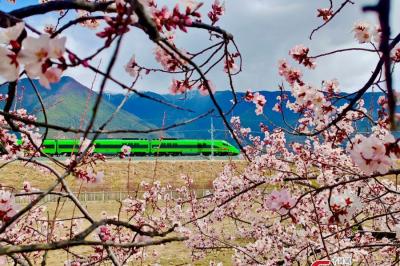 June 27,2019--Photo shows tourists from Shandong Province taking pictures on Potala Palace Square in Lhasa City, capital of southwest China's Tibet Autonomous Region. [China Tibet News/Tang Bin]  June 27,2019--Photo shows tourists boarding orderly at Mainling Airport of Nyingchi City, southwest China's Tibet Autonomous Region. [China Tibet News/Tang Bin]
 June 27,2019--Photo shows workers making traditional Tibetan storage boxes at anagricultural products processing cooperative of Gonjo County, Qamdo City, southwest China's Tibet Autonomous Region. [China Tibet News/Tenzin Xidan]
 June 27,2019--Photo shows electrical workers erecting power supply lines in Satsuo Village, Seni District of Nagqu City, southwest China's Tibet Autonomous Region. [China Tibet News/Gao Yujie]
 June 27,2019--Photo shows Losang and his family menbers harvesting rapeseed in the field in Zangdog Village of Dagze District, Lhasa City, capital of southwest China's Tibet Autonomous Region. [China Tibet News/Tang Bin]
 June 27,2019--Photo shows farmers weaving Pu Lu (Tibetan wool) in a weaving cooperative of Jedexoi Town, Shannan City, southwest China's Tibet Autonomous Region. [China Tibet News/Kelzang Jigme]
 June 27,2019--Photo shows Yangjentso sewing ethnic costumes at an ethnic costume Co., Ltd. in Jomda County of Qamdo City, southwest China's Tibet Autonomous Region. [China Tibet News/Chen Jun, Tenzin]
 June 27,2019--Photo shows the yoghurt processing workshop of a dairy industry Co., Ltd. in Lhasa City, capital of southwest China's Tibet Autonomous Region. [China Tibet News/Tang Bin]
 June 27,2019--Photo shows a panoramic view of Liudong Bridge in Lhasa City, capital of southwest China's Tibet Autonomous Region. [China Tibet News/Tang Bin]
June 27,2019--After 60 years of development, the modernization of Tibet's agriculture and animal husbandry has been continuously improved; characteristic industries of agricultural and animal husbandry have achieved rapid development. Tibet has achieved remarkable results in creating brand with Tibetan plateau characteristics, and built a large number of industrial bases for producing high-quality grain and oil, planting pollution-free vegetables and breeding dairy cows.
At present, Tibet has established a modern industrial system covering more than 20 categories, including energy, building materials, machinery, mining, light industry, food processing, ethnic handicraft industry, Tibetan medicine and so on. Economic structure has been continuously optimized; the tertiary industry has flourished, and tourism has been rapidly promoted within the whole region. In 2018, it has received 33.6873 million tourists, with the total tourist income of 49.014 billion yuan RMB; over 100,000 farmers and herdsmen have increased their income and become rich through tourism. New business forms, such as commercial logistics, financial insurance, e-commerce and others have been growing rapidly and becoming new economic growth points.
Under the strong leadership of the Party committee, Tibet has accelerated the construction of a modern economic system, highlighted the protection and improvement of people's livelihood, enhanced their happiness, and promoted sustained and healthy economic development, so as to lay a solid foundation for building a well-off society in an all-round way.
By: Liu Fang, Zhu Nan |
- Home
- News Tibet |Exclusive |China |World |Related News |Latest
- Documents White Papers |Others
- Photo Politics |Economy & Society |Culture & Religion |Human & Nature |Beautiful Tibet |Other Tibetan-Inhabited Area |Exchanges |Related
- Video News |Documentary |Micro-Video |Entertainment
- Art
- Tourism
- In Focus
- About Tibet






